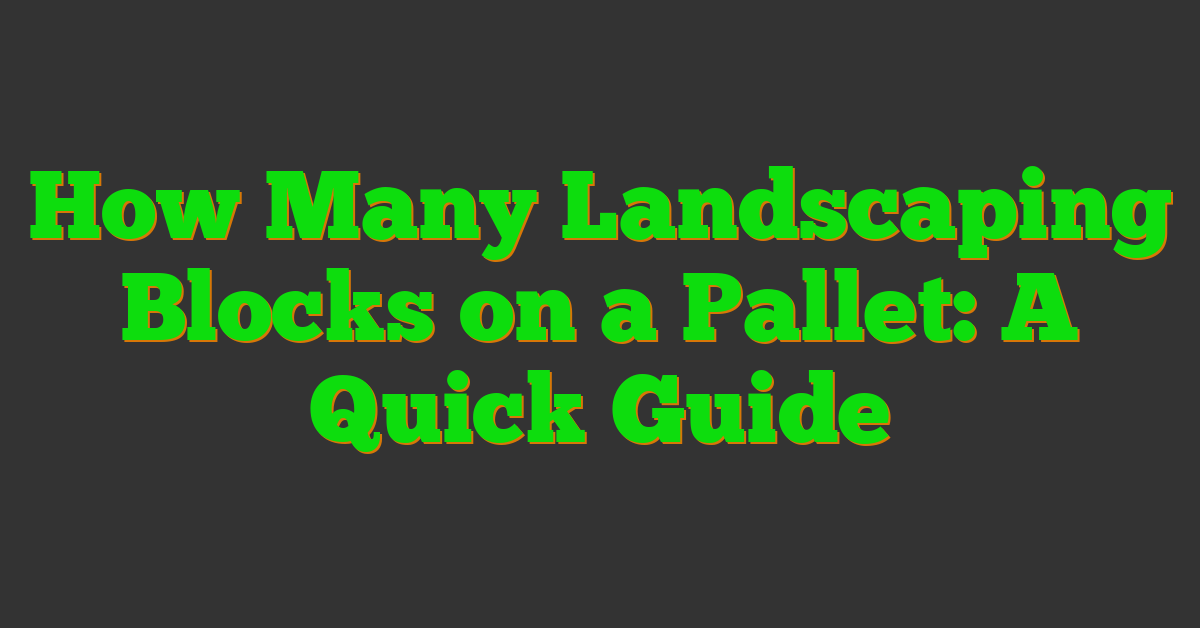Landscaping your yard can be a great way to enhance your property’s value and create an inviting outdoor space for you and your family to enjoy. However, if you’re new to landscaping, you may be wondering how much you should budget for this project. The answer is not straightforward, as the cost of landscaping varies depending on several factors.

Understanding landscaping costs is the first step in creating a budget that works for you. Factors that can impact the cost include the size and complexity of the project, the materials and supplies needed, and the amount of labor required for installation. Ongoing maintenance and upkeep should also be considered when creating your budget, as this can add to the overall cost of your landscaping project.
Key Takeaways
- Landscaping costs vary depending on several factors, such as project size, complexity, materials, and labor.
- Creating a landscaping budget requires understanding the costs involved and factoring in ongoing maintenance and upkeep.
- Enhancing your property’s value and creating an inviting outdoor space are some of the benefits of landscaping your yard.
Understanding Landscaping Costs

https://www.youtube.com/watch?v=yrclObzfbY8&embed=true
Landscaping can be a great way to improve the look and value of your property. However, before you start planning your dream landscape, it’s important to understand the costs involved. In this section, we’ll explore the factors that influence landscaping costs and provide an overview of average costs.
Factors Influencing Landscaping Costs
Several factors can influence the cost of your landscaping project. Some of these factors include:
Materials: The cost of materials, such as plants, mulch, and rocks, can vary depending on the type and quality you choose.
Labor: The cost of labor can vary depending on the complexity of your project and the experience of the landscaper.
Design cost: The cost of designing your landscape can vary depending on the complexity of your project and the experience of the designer.
Maintenance cost: The cost of maintaining your landscape can vary depending on the type of plants and features you choose.
Hardscaping costs: The cost of hardscaping features, such as patios, walkways, and retaining walls, can vary depending on the materials used and the complexity of the design.
Softscaping costs: The cost of softscaping features, such as plants, trees, and shrubs, can vary depending on the type and size of the plants.
Average Costs of Landscaping
According to various sources, the average cost of landscaping can range from $2,500 to $15,000 or more. The cost of landscaping can fluctuate considerably depending upon the geographical area, the complexity of the project, and the materials used.
For ongoing services such as mowing, fertilizing, and pest control, budgeting is essential, with monthly landscaping costs ranging from $100 to $500 or more. The American Society of Landscape Architects suggests that you should start with 5% to 10% of your home’s worth when budgeting for your project.
In conclusion, understanding the factors that influence landscaping costs and having a realistic budget in mind can help you plan and execute your dream landscape without breaking the bank.
Creating a Landscaping Budget
https://www.youtube.com/watch?v=fMhy39pvqXU&embed=true
Landscaping can be a significant expense when building a new home or updating an existing property. However, with a well-planned, accurate budget, you can ensure that your landscaping project is within your financial means. Here are some tips on creating a landscaping budget.
Determining Your Budget
The first step in creating a landscaping budget is to determine how much you can afford to spend. Consider your overall budget for your home or property and allocate a percentage of that budget to landscaping. The American Society of Landscape Architects suggests starting with 5% to 10% of your home’s worth as a general guideline for landscaping costs [1].
Once you have a general idea of your budget, consider the specific features you want to include in your landscaping project. For example, if you want to install a water feature or a large patio, these features will require a larger portion of your budget. On the other hand, if you simply want to plant some new trees and shrubs, this will be a less expensive project.
Allocating Funds Appropriately
After determining your budget, allocate the funds appropriately to ensure that your project stays within your financial means. Consider the costs of materials, labor, and any additional costs, such as permits or equipment rental.
Material costs will vary depending on the specific features you want to include in your landscaping project. For example, if you want to install a new retaining wall, the cost of materials will depend on the size and type of materials you choose. Labor costs will also vary depending on the scope of your project and the rates of the contractors you hire.
To get a more accurate estimate of the costs of your landscaping project, consider getting at least three estimates from different contractors [2]. This will give you a better idea of the average cost range for your project and help you allocate your funds appropriately.
By following these tips for creating a landscaping budget, you can ensure that your project stays within your financial means while still achieving the landscaping features you desire.
Landscaping Design and Planning
https://www.youtube.com/watch?v=e-wO-LqEQb4&embed=true
When it comes to landscaping, the design and planning phase is crucial to ensuring that your outdoor space is both functional and beautiful. Here are some tips to keep in mind as you navigate this stage of the process.
Choosing the Right Landscape Design
Before you start planning your landscape design, it’s important to consider your needs, preferences, and budget. Think about how you want to use your outdoor space, whether it’s for entertaining, gardening, or simply relaxing. Also, consider the style of your home and how you want your landscaping to complement it.
There are many different types of landscaping to choose from, including formal, informal, naturalistic, and modern. Each style has its own unique characteristics and can be tailored to suit your specific needs and preferences. Take some time to research different styles and decide which one is right for you.
Hiring a Professional Designer
If you’re not confident in your ability to design your own landscape, you may want to consider hiring a professional designer. A landscape designer or landscape architect can help you create a plan that meets your needs and fits within your budget.
When choosing a designer, look for someone who has experience designing landscapes that are similar to what you’re looking for. Ask to see examples of their previous work and check references to ensure that they have a track record of delivering high-quality results.
« What is Native Landscaping? A Friendly Introduction What is Landscape Mix? A Beginner’s Guide to Understanding Soil Amendments for Gardening »
Keep in mind that hiring a professional designer will add to the overall cost of your landscaping project. However, it may be worth the investment if you want to ensure that your outdoor space is both functional and beautiful.
In conclusion, taking the time to carefully plan your landscape design can help you create an outdoor space that you’ll love for years to come. Whether you decide to design your own landscape or hire a professional designer, make sure to consider your needs, preferences, and budget to ensure that you get the results you’re looking for.
Materials and Supplies

When budgeting for your landscaping project, one of the most significant expenses you will encounter is the cost of materials and supplies. This includes everything from plants and trees to mulch and landscaping rocks. Here are a few things to consider when selecting and purchasing these materials.
Selecting Quality Materials
When it comes to selecting materials for your landscaping project, quality is key. Choosing high-quality plants, trees, and shrubs will not only ensure that your landscaping looks beautiful, but it will also help to ensure that your investment lasts for years to come. Make sure to choose plants and trees that are healthy and disease-free, and ask your local nursery or garden center for recommendations on the best varieties for your area.
In addition to plants and trees, you will also need to consider the quality of other materials, such as mulch and landscaping rocks. Look for mulch that is made from high-quality materials and is free from contaminants, and choose landscaping rocks that are durable and will not break down over time.
Understanding Shipping Costs
If you are planning to purchase materials and supplies online or from a supplier that is not local to your area, it is important to factor in shipping costs when budgeting for your landscaping project. Shipping costs can vary widely depending on the size and weight of the materials you are purchasing, as well as your location and the location of the supplier.
To minimize shipping costs, consider purchasing materials from a supplier that is located closer to your area, or look for suppliers that offer free or discounted shipping on large orders. You may also be able to save money by purchasing materials in bulk, as many suppliers offer discounts for larger orders.
By carefully selecting high-quality materials and factoring in shipping costs, you can ensure that your landscaping project stays within your budget while still achieving the beautiful and functional outdoor space you desire.
Labor and Installation
https://www.youtube.com/watch?v=a2Ui9rGJ5JA&embed=true
When it comes to landscaping, one of the most significant costs you’ll encounter is the cost of labor and installation. Landscaping is a time-consuming and labor-intensive process, and it’s often best to leave it to the professionals. However, you can save money by doing some of the work yourself.
Costs of Hiring Landscapers
The cost of hiring landscapers varies depending on several factors, such as the size of the job, the complexity of the project, and the location. According to Forbes Home, the average cost of professional landscaping ranges from $2,600 to $13,700. The cost of labor makes up a significant portion of this expense, with landscapers charging anywhere from $50 to $100 per hour for a two-person crew or $25 to $50 per person.
It’s essential to get quotes from several landscapers before choosing one to ensure you’re getting a fair price. You should also ask for references and check reviews to ensure you’re hiring a reputable and experienced professional.
DIY vs. Professional Installation
While hiring a professional landscaper can be expensive, it can save you time and ensure that your landscaping project is done correctly. However, if you’re on a tight budget, you can save money by doing some of the work yourself.
DIY landscaping can be a rewarding experience, but it’s essential to be realistic about your abilities and the scope of the project. Some tasks, such as planting flowers or laying mulch, are relatively simple and can be done by most homeowners. However, more complex tasks, such as installing a deck or building a retaining wall, require specialized skills and equipment.
If you’re considering DIY landscaping, it’s essential to factor in the cost of tools and supplies. According to Bob Vila, the cost of materials for a deck installation can be as much as $5,000, while the cost of a pond installation can range from $1,300 to $6,000.
In conclusion, the cost of labor and installation is a significant expense when it comes to landscaping. While hiring a professional landscaper can be expensive, it can save you time and ensure that your landscaping project is done correctly. If you’re on a tight budget, you can save money by doing some of the work yourself, but it’s essential to be realistic about your abilities and the scope of the project.
Project Size and Complexity

When it comes to budgeting for a landscaping project, the size and complexity of the project are two of the most significant factors that will affect the overall cost. Here are some things to consider when it comes to project size and complexity:
Small vs. Large Scale Projects
The size of your yard will play a significant role in determining the overall cost of your landscaping project. A small yard will naturally require less work and fewer materials, which will result in a lower cost. On the other hand, a large property will require more time, labor, and materials, which will increase the overall cost of the project.
If you have a large property, you may want to consider breaking the project down into smaller, more manageable sections. This can help you spread out the cost over time and make the project more affordable.
Complexity and Custom Features
The complexity of your landscaping project will also play a significant role in determining the overall cost. For example, if you’re planning to install an outdoor kitchen, water fountain, retaining wall, shed, decks, pergolas, fireplaces, pool house, or any other custom feature, you can expect the cost to be higher than a simple landscaping project.
Custom features require more time, skill, and materials to install, which will increase the overall cost of the project. However, they can also add significant value to your home and make your outdoor space more enjoyable and functional.
When it comes to budgeting for a landscaping project, it’s essential to consider the size and complexity of the project carefully. By doing so, you can ensure that you have a realistic idea of how much the project will cost and avoid any surprises down the road.
Ongoing Maintenance and Upkeep
https://www.youtube.com/watch?v=MFryRsEw3rc&embed=true
Keeping your landscape looking beautiful and healthy requires ongoing maintenance and upkeep. This includes regular lawn care, tree trimming, lawn mowing, and lawn aeration. Estimating maintenance costs can be challenging, but there are a few things to keep in mind that can help.
Estimating Maintenance Costs
The cost of ongoing maintenance and upkeep will depend on a variety of factors, including the size of your property, the complexity of your landscape design, and the specific services you require. According to Tracer Companies, monthly landscaping costs can range from $100 to $500 or more. This includes ongoing services such as mowing, fertilizing, and pest control.
To get a more accurate estimate of your maintenance costs, it’s a good idea to get quotes from several landscape maintenance services. Be sure to ask about any additional fees, such as charges for removing debris or hauling away yard waste.
Reducing Long-Term Expenses
While ongoing maintenance is necessary to keep your landscape looking its best, there are a few things you can do to reduce long-term expenses. For example, planting native plants that are well-suited to your climate can reduce the need for watering, fertilizing, and pest control. Additionally, choosing low-maintenance landscaping features such as hardscaping or xeriscaping can reduce the need for ongoing maintenance.
Regular maintenance can also help reduce long-term expenses by catching small problems before they become more serious. For example, regularly trimming trees can prevent them from becoming overgrown and potentially damaging your property. Regular lawn care can also help prevent weeds and other problems from taking hold.
In summary, ongoing maintenance and upkeep are essential for keeping your landscape looking its best. By getting quotes from several landscape maintenance services and choosing low-maintenance landscaping features, you can help reduce long-term expenses and keep your landscape looking beautiful for years to come.
Enhancing Property Value
https://www.youtube.com/watch?v=VS0o2cWCq-M&embed=true
If you’re planning to sell your home, or just want to increase its value, landscaping is an excellent investment. A well-designed and maintained landscape can increase your home’s value by up to 15-20% on average [1]. Here are some ways that landscaping can enhance your property value:
Landscaping for Curb Appeal
Curb appeal refers to the attractiveness of your home’s exterior when viewed from the street. A well-designed landscape can significantly improve your home’s curb appeal and make it more attractive to potential buyers. This can lead to a faster sale at a higher price.
To improve your home’s curb appeal, consider adding landscape curbing, which can define your garden beds and add a finished look to your yard. You can also add some colorful plants and flowers to your front yard to make it more inviting. Make sure to choose plants that are easy to maintain and that thrive in your area.
ROI of Landscaping Investments
Landscaping is an investment, and like any investment, you want to make sure you’re getting a good return on your money. The good news is that landscaping can provide a high return on investment (ROI). According to the American Society of Landscape Architects, a well-designed landscape can add up to 15% to the value of your home compared to other houses on your street [2].
To get the most bang for your buck, focus on landscaping projects that provide the highest ROI. Some examples include adding a patio or deck, which can provide an outdoor living space that is both functional and attractive. You can also add some outdoor lighting to highlight your home’s best features and make it more accessible at night.
In conclusion, landscaping is an excellent investment that can significantly enhance your property value. By focusing on curb appeal and investing in landscaping projects with a high ROI, you can increase your home’s value and enjoy a beautiful outdoor space at the same time.
[1] Bankrate. (n.d.). Does Landscaping Increase Home Value? Retrieved from https://www.bankrate.com/homeownership/landscaping-increase-home-value/
[2] HGTV. (n.d.). Budgeting for a Landscaping Project. Retrieved from https://www.hgtv.com/outdoors/outdoor-remodel/budgeting-for-a-landscaping-project
Additional Landscaping Features

When it comes to landscaping, there are many additional features you can incorporate into your design to make it truly unique and beautiful. Here are a few options to consider:
Incorporating Hardscape Elements
Hardscape elements can add a lot of interest and functionality to your landscaping design. These elements include things like retaining walls, walkways, and walls. Retaining walls are a great way to add dimension to your yard, while walkways can provide a clear path for you and your guests to navigate. Walls can be used to create privacy or to add a focal point to your design. When it comes to hardscaping, the options are truly endless.
Softscaping and Planting Options
Softscaping involves the use of plants and other organic materials to create a beautiful landscape. Flower beds are a great way to add color and texture to your yard, while trees and shrubs can provide shade and privacy. When selecting plants for your yard, it’s important to consider the climate and soil conditions in your area. You’ll also want to consider the amount of maintenance required for each plant.
In addition to traditional planting options, you may also want to consider incorporating edible plants into your landscape design. Herbs, fruits, and vegetables can not only add visual interest to your yard, but they can also provide you with fresh produce to enjoy.
Budgeting for Additional Features
When it comes to budgeting for additional landscaping features, it’s important to consider both the cost of materials and the cost of labor. Hardscaping elements such as retaining walls and walkways can be more expensive due to the cost of materials and labor. Softscaping options such as flower beds and trees can also be costly, depending on the size and number of plants you choose.
To keep costs down, consider incorporating a mix of hardscaping and softscaping elements into your design. You may also want to consider doing some of the work yourself to save on labor costs. With a little creativity and planning, you can create a beautiful and functional landscape design that fits within your budget.
Frequently Asked Questions
https://www.youtube.com/watch?v=BhHqm6xRoeQ&embed=true
What factors influence the average cost of landscaping around a home?
Several factors influence the average cost of landscaping around a home. The size of your yard, the complexity of the project, and the materials you choose are all factors that can affect the cost. Additionally, the region you live in can also affect the cost of landscaping. For example, the cost of labor and materials can be higher in urban areas than in rural areas.
How can I calculate the cost of landscaping for my yard?
To calculate the cost of landscaping for your yard, you should consider the size of your yard, the materials you want to use, and the complexity of the project. You can get an estimate of the cost by consulting with a landscaping professional or using an online cost calculator. It’s important to keep in mind that the cost of landscaping can vary widely depending on the factors mentioned above.
What are some cost-effective strategies for landscaping?
There are several cost-effective strategies for landscaping, such as using native plants, which are typically less expensive and require less maintenance than non-native plants. Another cost-effective strategy is to use mulch or gravel instead of grass in certain areas of your yard. Additionally, you can save money by doing some of the work yourself, such as planting and watering.
How much should I typically budget for the maintenance of my landscaping per month?
The amount you should budget for the maintenance of your landscaping per month can vary depending on the size of your yard and the services you require. According to Tracer Companies, monthly landscaping costs can range from $100 to $500 or more. It’s important to factor in ongoing services such as mowing, fertilizing, and pest control when budgeting for maintenance.
What is the average rate for landscaping services per hour?
The average rate for landscaping services per hour can vary depending on the region you live in and the complexity of the project. According to Bob Vila, the typical range for landscaping costs is $1,277 to $5,856, with most homeowners paying a national average of $3,415. It’s important to get an estimate from a landscaping professional before hiring them for a project.
Can you suggest a landscaping budget for a standard front yard?
The cost of landscaping a standard front yard can vary depending on the factors mentioned above. According to Homes & Gardens, landscaping can cost anywhere between $2,500 to $15,000, or $50-$100 per hour or $30-$100 a week. It’s important to consult with a landscaping professional to get an accurate estimate for your specific project.










